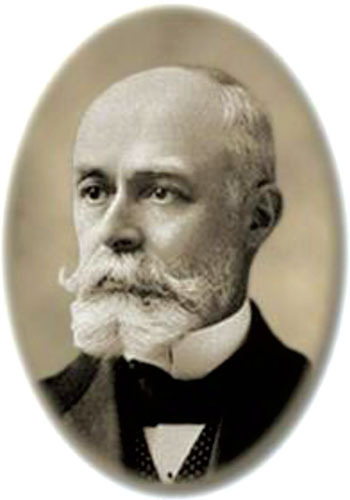
Alexandre Edmond Becquerel (1820–1891)
Four successive generations of the Becquerel family were educated at the prestigious French scientific institution of higher learning, the École Polytechnique, and became physics professors at the French Museum of Natural History. Alexandre Edmond Becquerel was the son of Antoine César (1788– 1878), discoverer of piezoelectricity; father of Antoine Henri (1852– 1908), who discovered radioactivity; and the grandfather of Jean Antoine (1878–1953), who is best known for his work on relativity and the discovery of polarization rotation in the presence of a magnetic field. Though all of these notable scientists carried out a variety of experiments related to optics, it was Alexandre Edmond Becquerel who made the greatest contributions to the field.

Born in Paris on March 24, 1820, Alexandre Edmond Becquerel became first a student, and then an assistant, to his father, and many of his investigations are associated with those of the elder Becquerel. Edmond was, however, particularly intrigued by light and embarked on in-depth studies of the subject. He examined the spectroscopic characteristics and the photochemical effects of the sun and was especially interested in the phenomena of fluorescence and phosphorescence. To aid in his study of the latter, Becquerel invented the phosphoroscope, a device capable of measuring the duration of time between the exposure of a solid, liquid, or gas to a light source and the substance's exhibition of phosphorescence. Through the use of the phosphoroscope, the physicist was able to more accurately determine whether or not certain materials exhibited phosphorescence or fluorescence, because one of the key differences between the phenomena is the duration of the excited state lifetime, which is the interval of time that passes before the effect occurs following the absorption of light. (Fluorescence occurs almost instantaneously after excitation, whereas phosphorescence is characterized by a much longer excited state lifetime). The phosphoroscope also enabled Becquerel to discover phosphorescence in a number of materials that were previously not believed to exhibit the effect.
Alexandre Edmond Becquerel's work with fluorescence and phosphorescence led him in the late 1850s to develop the idea of using these effects in light sources. He experimentally applied various luminescent materials as coatings to electric discharge tubes, and though he never succeeded in producing a commercial light, his work eventually led to the development of the fluorescent lamps that are widely used in modern times. Findings from many of Becquerel's studies of luminescence and other areas of optics were published in 1867 and 1868 in the two-volume treatise entitled La Lumiere, ses causes et ses effets. His appointment at the Museum of Natural History occurred in 1878, so that he directly succeeded his well-known father. He was a member of the Académie des Sciences from 1863 to his death on May 11, 1891.
William Henry Bragg (1862–1942)
William Henry Bragg was a professor of physics and mathematics and was known for making important contributions to many scientific disciplines. Born in Westward, Cumberland in the United Kingdom on July 2, 1862, Bragg was thoroughly educated while attending Market Harborough Grammar School and King William's College on the Isle of Man. Later, he studied physics at the Cavendish Laboratory, University of Cambridge, and he was elected to the Professorship of Mathematics and Physics at the University of Adelaide, in Southern Australia. Bragg's career continued to flourish, and he was subsequently appointed Cavendish Professor of Physics at Leeds, Quain Professor of Physics at the University College London, and Fullerian Professor of Chemistry at the Royal Institution.

Bragg had numerous research interests, but the work that earned him a rank as one of the great leaders in science was his historic advancements in X-ray crystallography. Working with his son William Lawrence Bragg, he developed a method of bombarding single crystals with high-energy X-rays emitted by specially constructed vacuum tubes. When X-rays pass through the single crystal, they are diffracted, according to a law discovered by the Braggs, and are thus quantitatively deviated from their course. Patterns of diffracted X-rays can be imaged using photographic film, because the X-rays expose grains of silver bromide. By examining the pattern of X-rays diffracted by various crystals, Bragg and his son were able to establish some fundamental mathematical relationships between an atomic crystal structure and its diffraction pattern. For this achievement, William Henry Bragg and William Lawrence Bragg were awarded the Nobel Prize in Physics in 1915.
Today, thousands of crystal structures have been determined for a wide spectrum of molecules ranging from simple organic compounds to complex multichained proteins and nucleic acids. X-ray diffraction has been a fundamental tool in the sciences of molecular biology and biochemistry for the past fifty years. The contributions made by X-ray diffraction experiments are almost unparalleled by any other single technique.
Throughout his career, Bragg was noted for his many contributions to a wide variety of scientific endeavors. He also had a sense of humor and is noted for the following quote on the controversy between the electromagnetic energy wave versus particle theories: “Physicists use the wave theory on Mondays, Wednesdays, and Fridays and the particle theory on Tuesdays, Thursdays, and Saturdays.”
Bragg turned his attention to detection of sound in water during the First World War and spent several years conducting research on the detection and measurement of sound with the intention of locating submarines. Following the war, Bragg was knighted and earned the Order of Merit in 1931. He was elected president of the Royal Society in 1935. His reputation earned Bragg honorary doctorate degrees from over fifteen universities, and he was a distinguished member of many leading foreign science societies. Bragg was awarded the Royal Society's Rumford Medal in 1916 and the highest award, the Copley Medal, in 1930. After a lifetime of achievement, Bragg died quietly on March 10, 1942.




